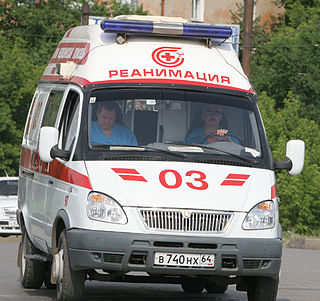This article needs to be updated.(March 2018) |

Healthcare in Serbia is delivered by means of a universal health care system.
This article needs to be updated.(March 2018) |

Healthcare in Serbia is delivered by means of a universal health care system.
The general reorientation of health services towards social and preventive medicine and primary health care was officially accepted in the Federal Republic of Yugoslavia after the Second World War. It built on some fundamental principles introduced in the 1930s by Dr Andrija Štampar. Primary health care (at that time called basic care) in the Yugoslav health system held a priority position for more than 40 years. However, from the beginning of the 1960s, preserving primary health care as the "center of the system" faced serious challenges, including a centralized and vertically programmed approach to preventive medicine, inadequate skills and competencies of health professionals in health promotion, and a relatively low economic and social status of health professionals in primary health care. [1]
Between the 1960s and 1980s, little effort was made to improve the status and performance of primary health care. Meanwhile, an experiment with self-governing communities of interest in the health sector further decreased the efficiency and quality of services. [1]
With the violent disintegration of the former Yugoslavia in 1991, the already weakened and structurally distorted economy of the Republic of Serbia entered an acute phase of the crisis, with drastic consequences to the health care system and to other social sectors. Due to dwindling real resources, as well as to an inefficient, over-extended and poorly managed public health sector, health care has been facing huge problems: frequent shortage of basic drugs and medical supplies, inadequate nutrition of patients, obsolete and broken medical equipment, and lack of basic materials, a deteriorating infrastructure and demoralized staff. Consequently, the quality and quantity of health services sharply deteriorated. [2]

The first strategic paper was enacted two years after the political changes of October 5, 2000 and later in comparison with reforms in other welfare programs. Only in 2005 were the new Laws regulating health care and health insurance adopted. The dominant provider of health care services is still the state, and the organization of public health care facilities has been characterized by an insufficiently clear division of levels of care. Compared to the period of socialism, the most striking changes were made with the introduction of mandatory health insurance and the widening of the scope of work and types of private health care services.
Along with the dominance of the public sector, the activities of the private health care sector have been steadily increasing. They are mainly offered at the level of primary health care, but also at the level of highly profitable specialized health care services. However, any of the so far implemented reforms did not prevent the parallel existence of the two sectors. The functioning of the private sector is still lacking completely clear regulations. [3]
Private health insurance has a short history; it is regulated by the Regulation on Voluntary Health Insurance in Serbia of 2008. Private health insurance is designed as a form of substitution for those without a public insurance and for those opting for higher standards.
In 2014, the Chairperson of "Doctors Against Corruption" was appointed a Special Adviser to the Ministry of Health. [4]
In October 2015, the List of Licensed Medical Practitioners appeared on the Serbian Medical Chamber's website, which wasn't previously accessible to the citizens. [5]
The Health Protection Act and the Health Insurance Act came into force on 11 April 2019. There is a list of health institutions that cannot be privately owned:
A Register of Health Institutions is to be established by the Agency for Business Registers of Serbia by October 11, 2020. A common waiting list system is to be established.
Patients are obliged to submit to targeted preventive examinations. If they fail to undergo a mandatory screening without justification, they have to contribute a maximum of 35% of the total cost of health services if they are diagnosed before the next screening cycle begins.
Gifts worth more than 5% of the average monthly net salary in Serbia to health professionals are outlawed. [6]
The healthcare system is managed by the National Health Insurance Fund (NHIF), which covers all citizens and permanent residents. All employees, self-employed persons, and pensioners must pay contributions to it. Contributions are based on a sliding scale, with wealthier members of society paying higher percentages of their income. [7] Despite this, corruption still remains a serious problem due to low salaries, with many doctors demanding bribes in exchange for better treatment, although there is a major campaign against corruption from the government and NGOs. [8]
As of 2014, the expenditure on health care in Serbia was 10.37% of GDP in 2014, US$1,312 per capita. [9] Also, as of 2014, Serbia had 308 doctors per 100,000 people (360 per 100,000 people was the European Union (EU) average) and 628 non-doctoral medical staff per 100,000 people (1,199 per 100,000 people was the EU average). [9] Although there is a trend toward a decreasing number of hospital beds per 100,000 people in Europe due to better efficiency and diagnostics, Serbia is among the countries in Europe with 552 hospital beds per 100,000 people. [9] [10] In terms of the availability of medical equipment, Serbia is slightly trailing behind the average of EU countries. [9]
The Government of Serbia is working with the World Bank to improve the quality and efficiency of Serbia's healthcare system. [11]
Self care is mainly practiced when a patient is already ill versus as a preventive measure. Care is usually sought from healthcare professionals such as doctors or nurses where bribes are commonly expected, but some folk medications are used such as teas, vinegar, herbs, and vitamins. Changes in activity levels such as more rest or increased exercise are sometimes used as curative measures for illness, and perceived causes of illness may be improper diet or fate. [12] Most former Yugoslavians feel health is not the absence of disease, but rather it is “wealth and the most important thing in life" and "to have enough strength”. [13]
Health care reform is for the most part governmental policy that affects health care delivery in a given place. Health care reform typically attempts to:

Medicare is an unofficial designation used to refer to the publicly funded single-payer healthcare system of Canada. Canada's health care system consists of 13 provincial and territorial health insurance plans, which provide universal healthcare coverage to Canadian citizens, permanent residents, and depending on the province or territory, certain temporary residents. The systems are individually administered on a provincial or territorial basis, within guidelines set by the federal government. The formal terminology for the insurance system is provided by the Canada Health Act and the health insurance legislation of the individual provinces and territories.

Publicly funded healthcare is a form of health care financing designed to meet the cost of all or most healthcare needs from a publicly managed fund. Usually this is under some form of democratic accountability, the right of access to which are set down in rules applying to the whole population contributing to the fund or receiving benefits from it.

The healthcare industry is an aggregation and integration of sectors within the economic system that provides goods and services to treat patients with curative, preventive, rehabilitative, and palliative care. It encompasses the creation and commercialization of products and services conducive to the preservation and restoration of well-being. The contemporary healthcare sector comprises three fundamental facets, namely services, products, and finance. It can be further subdivided into numerous sectors and categories and relies on interdisciplinary teams of highly skilled professionals and paraprofessionals to address the healthcare requirements of both individuals and communities.

Primary care is the day-to-day healthcare given by a health care provider. Typically this provider acts as the first contact and principal point of continuing care for patients within a healthcare system, and coordinates other specialist care that the patient may need. Patients commonly receive primary care from professionals such as a primary care physician, a physician assistant, a physical therapist, or a nurse practitioner. In some localities, such a professional may be a registered nurse, a pharmacist, a clinical officer, or an Ayurvedic or other traditional medicine professional. Depending on the nature of the health condition, patients may then be referred for secondary or tertiary care.

Health care in Saudi Arabia is a national health care system in which the government provides free universal healthcare coverage through a number of government agencies. There is also a growing role and increased participation from the private sector in the provision of health care services. Saudi Arabia has been ranked among the 26 best countries in providing high quality healthcare.

The Ministry of Health is the ministry of the Government of Turkey responsible for proposing and executing the government policy on health, planning and providing healthcare and protecting consumers. Likewise, it is responsible for proposing and executing the government policy on social cohesion and inclusion, family, protection of minors, youth and of care for dependent or disabled persons. The Ministry is headquartered in the Bakanlıklar in Ankara.

Healthcare in Russia is provided by the state through the Federal Compulsory Medical Insurance Fund, and regulated through the Ministry of Health. The Constitution of the Russian Federation has provided all citizens the right to free healthcare since 1993. In 2008, 621,000 doctors and 1.3 million nurses were employed in Russian healthcare. The number of doctors per 10,000 people was 43.8, but only 12.1 in rural areas. The number of general practitioners as a share of the total number of doctors was 1.26 percent. There are about 9.3 beds per thousand population—nearly double the OECD average.

Healthcare in Turkey consists of a mix of public and private health services. Turkey introduced universal health care in 2003. Known as Universal Health Insurance Genel Sağlık Sigortası, it is funded by a tax surcharge on employers, currently at 5%. Public-sector funding covers approximately 75.2% of health expenditures.

As literacy and socioeconomic status improves in Ethiopia, the demand for quality service is also increasing. Besides, changes in the demographic trends, epidemiology and mushrooming urbanization require more comprehensive services covering a wide range and quality of curative, promotive and preventive services.
Healthcare in Finland consists of a highly decentralized three-level publicly funded healthcare system and a much smaller private sector. Although the Ministry of Social Affairs and Health has the highest decision-making authority, specific healthcare precincts are responsible for providing healthcare to their residents as of 2023.
Kenya's health care system is structured in a step-wise manner so that complicated cases are referred to a higher level. Gaps in the system are filled by private and church run units.
Healthcare in Georgia is provided by a universal health care system under which the state funds medical treatment in a mainly privatized system of medical facilities. In 2013, the enactment of a universal health care program triggered universal coverage of government-sponsored medical care of the population and improving access to health care services. Responsibility for purchasing publicly financed health services lies with the Social Service Agency (SSA).

Health care in Cyprus accounted for 7% of its GDP in 2014. Between 2010 and 2014, health care spending increased from $1,705 per capita to $2,062 per capita. Cyprus has a multi-payer health care system that consists of a public and private sector. The public sector is funded by payroll, earnings taxes, and employer contributions. The public sector healthcare provides social insurance for the employed, self-employed, and for several types of civil servant. A universal national health system, known as GESY, was implemented in Cyprus in June 2019. The new system aims to provide affordable and effective medical care to all people residing permanently in Cyprus.
Examples of health care systems of the world, sorted by continent, are as follows.
According to the Constitution of Albania, citizens are entitled to healthcare. The healthcare system in Albania is primarily public. The public system is made up of three tiers: primary care, secondary care, and tertiary care. Primary healthcare covers basic health needs. Secondary healthcare is needed when seeing a specialist after being referred to by a general doctor. Tertiary healthcare funds highly specialized medical care that is needed over a long duration of time. There are over 400 public clinics that offer both primary and secondary healthcare services, along with over 40 public hospitals that offer tertiary healthcare services.

A new measure of expected human capital calculated for 195 countries from 1990 to 2016 and defined for each birth cohort as the expected years lived from age 20 to 64 years and adjusted for educational attainment, learning or education quality, and functional health status was published by The Lancet in September 2018. Latvia had the twenty-first highest level of expected human capital with 23 health, education, and learning-adjusted expected years lived between age 20 and 64 years.

As of 2019 Lithuanian life expectancy at birth was 76.0 and the infant mortality rate was 2.99 per 1,000 births. This is below the EU and OECD average.

In the past, Kosovo’s capabilities to develop a modern health care system were limited. Low GDP during 1990 worsened the situation even more. However, the establishment of the Faculty of Medicine in the University of Pristina marked a significant development in health care. This was also followed by launching different health clinics which enabled better conditions for professional development.